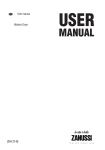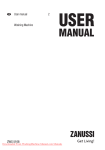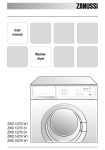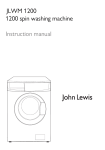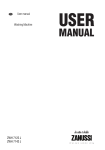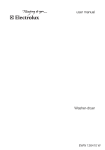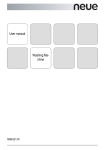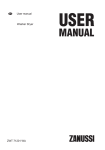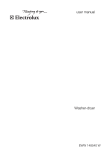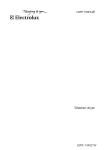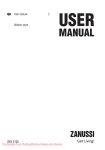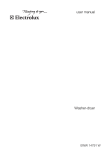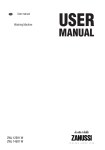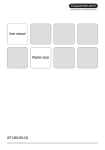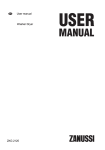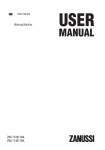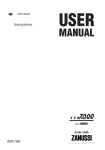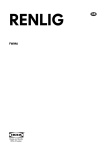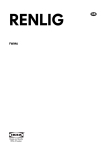Download User manual Washer-dryer ZKG 7125 ZKG 7145 ZKG 7165
Transcript
EN User manual Washer-dryer ZKG 7125 ZKG 7145 ZKG 7165 Contents Safety information _ _ _ _ _ _ _ _ _ _ _ _ _ _ _ _ _ _ 2 Product description _ _ _ _ _ _ _ _ _ _ _ _ _ _ _ _ _ 4 Control panel _ _ _ _ _ _ _ _ _ _ _ _ _ _ _ _ _ _ _ _ 5 Washing Programmes _ _ _ _ _ _ _ _ _ _ _ _ _ _ _ _ 7 Automatic Drying programmes _ _ _ _ _ _ _ _ _ _ _ _ 9 Drying Programmes _ _ _ _ _ _ _ _ _ _ _ _ _ _ _ _ 10 Helpful hints and tips _ _ _ _ _ _ _ _ _ _ _ _ _ _ _ 10 Drying Hints _ _ _ _ _ _ _ _ _ _ _ _ _ _ _ _ _ _ _ _ 12 First use _ _ _ _ _ _ _ _ _ _ _ _ _ _ _ _ _ _ _ _ _ _ 12 Personalisation _ _ _ _ _ _ _ _ _ _ _ _ _ _ _ _ _ _ Daily Use _ _ _ _ _ _ _ _ _ _ _ _ _ _ _ _ _ _ _ _ _ Use - Drying _ _ _ _ _ _ _ _ _ _ _ _ _ _ _ _ _ _ _ _ Care and cleaning _ _ _ _ _ _ _ _ _ _ _ _ _ _ _ _ _ What to do if… _ _ _ _ _ _ _ _ _ _ _ _ _ _ _ _ _ _ Technical data _ _ _ _ _ _ _ _ _ _ _ _ _ _ _ _ _ _ _ Consumption values _ _ _ _ _ _ _ _ _ _ _ _ _ _ _ _ Installation _ _ _ _ _ _ _ _ _ _ _ _ _ _ _ _ _ _ _ _ Environmental concerns _ _ _ _ _ _ _ _ _ _ _ _ _ _ 13 13 15 16 19 23 23 24 27 Subject to change without notice Safety information Important! Read carefully & keep for future reference. • The safety of Your appliance complies with the industry standards and with legal requirements on the safety of appliances. However, as manufacturers, we feel it is our duty to provide the following safety notes. • It is most important that this instruction book should be retained with the appliance for future reference. Should the appliance be sold or transferred to another owner, or should you move house and leave the appliance, always ensure that the book is supplied with the appliance in order that the new owner can get to know the functioning of the appliance and the relevant warnings. • You MUST read them carefully before installing or using the appliance. • Before first starting up, check the appliance for any damage incurred during transport. Never connect up a damaged appliance . If parts are damaged, contact your supplier. • If the appliance is delivered in the winter months when there are minus temperatures. Store it at room temperature for 24 hours before using for the first time. General safety • It is dangerous to alter the specifications or attempt to modify this product in any way. • During high temperature wash programmes the door glass may get hot. Do not touch it! • Make sure that small pets and children do not climb into the drum. To avoid this, please check into the drum before using. 2 • Any objects such as coins, safety pins, nails, screws, stones or any other hard, sharp material can cause extensive damage and must not be placed into the machine. • Only use the advised quantities of fabric softener and detergent. Damage to the fabric can ensue if you overfill. Refer to the manufacturer’s recommendations of quantities. • Wash small items such as socks, laces, washable belts etc in a washing bag or pillow case as it is possible for such items to slip down between the tub and the inner drum. • Do not use your washing machine to wash articles with whalebones, material without hems or torn material. • Always unplug the appliance and turn off the water supply after use, cleaning and maintenance. • Under no circumstances should you attempt to repair the machine yourself. Repairs carried out by inexperienced people may cause injury or serious malfunctioning. Contact your local Service Centre. Always insist on genuine spare parts. Installation • This appliance is heavy. Care should be taken when moving it. • When unpacking the appliance, check that it is not damaged. If in doubt, do not use it and contact the Service Centre. • All packing and transit bolts must be removed before use. Serious damage can occur to the product and to property if this is not adhered to. See relevant section in the user manual. • After having installed the appliance, check that it is not standing on the inlet and drain hose and the worktop is not pressing the electrical supply cable against the wall. • If the machine is situated on a carpeted floor, please adjust the feet in order to allow air to circulate freely under the appliance. • Always be sure, that there is no water leakage from hoses and their connections after the installation. • If the appliance is installed in a location subject to frost, please read the “dangers of freezing” chapter. • Any plumbing work required to install this appliance should be carried out by a qualified plumber or competent person. • Any electrical work required to install this appliance should be carried out by a qualified electrician or competent person. Use • This appliance is designed for domestic use. It must not be used for purposes other than those for which it was designed. • Only wash and dry fabrics which are designed to be machine washed or dried. Follow the instructions on each garment label • Do not overload the appliance. See the Washing Programme Table. • Before washing, ensure that all pockets are empty and buttons and zips are fastened. Avoid washing frayed or torn articles and treat stains such as paint, ink, rust, and grass before washing. Underwired bras must NOT be machine washed. • Garments which have been in contact with volatile petroleum products should not be machine washed. If volatile cleaning fluids are used, care should be taken to ensure that the fluid is removed from the garment before placing in the machine. • As some duvets and eiderdowns should be washed/ dried in large commercial machines because of their bulk, please check with the manufacturer of the item before washing in a domestic machine. • The users should always check that they have not left their gas lighters (disposable or otherwise) in their clothing. • Never tumble dry items that have had contact with chemicals such as dry cleaning fluid. These are of a volatile nature and could cause an explosion. Only tumble dry items which have been washed in water or require airing. • Plastic detergent dispensers should not remain in the drum during the drying cycle, as the plastic used is not designed to withstand the heat. If you wish to washthrough-to-dry you should use the conventional detergent dispenser drawer. • Never pull the power supply cable to remove the plug from the socket; always take hold of the plug itself. • Never use your new appliance if the power supply cable, the control panel, the working surface or the base are damaged so that the inside of the appliance is accessible. Child safety • This appliance is not intended for use by person (including children) with reduced physical sensory or mental capabilities or lack of experience and knowledge unless they have been given supervision or instruction concerning use of the appliance by a person responsible for their safety. • Children should be supervised to ensure that they do not play with the appliance. • The packaging components (e.g. plastic film, polystyrene) can be dangerous to children - danger of suffocation! Keep them out of children’s reach • Keep all detergents in a safe place out of children’s reach. • Make sure that children or pets do not climb into the drum. To prevent children and pets becoming trapped inside the drum this machine incorporates a special feature. To activate this device, rotate the button (without pressing it) inside the door clockwise until the groove is horizontal. If necessary use a coin. To disable this device and restore the possibility of closing the door, rotate the button anti-clockwise until the groove is vertical. 3 Product description 1 2 3 4 5 6 Detergent dispenser drawer Control panel Door opening handle Rating plate Drain pump Adjustable feet 1 2 3 4 5 6 Detergent dispenser drawer Compartment for detergent used for prewash and soak phase or for stain remover used during the stain action phase (if available). The prewash and soak detergent is added at the beginning of the wash programme. The stain remover is added during the stain action phase. Compartment for powder or liquid detergent used for main wash. If using liquid detergent pour it just before starting the programme. Compartment for liquid additives (fabric softener, starch). Follow the product manufacturer’s recommendations on quantities to use and do not exceed the «MAX» mark in the detergent dispenser drawer. Any fabric softener or starching additives must be poured into the compartment before starting the wash programme. 4 Control panel On the following page there is a picture of the control panel. It shows the programme selector dial as well as the buttons, pilot lights and the display. These are presented by relevant numbers on the following pages. 10 9 1 1 2 3 4 5 2 Programme selector dial Spin button Autodry button Drying time button Super quick button 3 4 6 7 8 9 10 5 6 7 8 Extra rinse button Start/Pause button Delay start button Door pilot light Display Table of symbols = Rinse hold 1-8 Programme selector dial, spin speed button, drying level and time, and available options Programme Selector Dial It allows you to switch the appliance on/off and/or to select a programme. Spin By pressing this button you can change the spin speed of the selected programme or to select Rinse Hold option. Rinse hold By selecting this function the water of the last rinse is not emptied out to prevent the fabrics from creasing. Before opening the door it will be necessary to empty out the water. To empty out the water, please read the paragraph «At the end of the programme». = Child Safety Lock Automatic Dry By pressing this button you can choose the required degree of drying for cottons and synthetics: • Cupboard dry (Cottons and Synthetics) • Iron dry (Cottons) The pilot light corresponding to the selected dryness degree will illuminate. Drying Time If you wish to carry out a timed drying programme, press this button until the drying time you want appears on the display according to the fabrics (cottons or synthetics) you have to dry. For Cottons you can select a drying time from 10 minutes to 250 minutes (4.10). For Synthetics you can select a drying time from 10 minutes to 130 minutes (2.10). Every time you press this button the drying time increases by 5 mins. 5 Available options: Super Quick Short cycle for lightly soiled items or for laundry which needs only freshening up. We recommend you to reduce the fabrics loading. Extra Rinse This appliance is designed to save energy. If it necessary to rinse the laundry using an extra quantity of water (extra rinse), select this option. Some additional rinses will be performed. This option is recommended for people who are allergic to detergents, and in areas where the water is very soft. Start Pause This button allows you to start or to interrupt the selected programme. Delay Start The programme can be delayed from 30 min - 60 min - 90 min, 2 hours and then by 1 hour up to a maximum of 20 hours by means of this button. Door light The pilot light 9 illuminates when the programme starts and indicates if the door can be opened: • light on: the door cannot be opened. The machine is working or has stopped with water left in the tub. • light off: the door can be opened. The programme is finished or the water has been emptied out. • light blinking: the door is opening in a few minutes. 10 Display 10.1 6 10.2 The display shows the following information: 10.1: Child safety lock This device permits you to leave the appliance unattended during it's functioning. 10.2: • Duration of the selected programme After selecting a programme, the duration is displayed ). The durain hours and minutes (for example tion is calculated automatically on the basis of the maximum recommended load for each type of fabric. After the programme has started, the time remaining is updated every minute. • Selected drying time After selecting a drying programme the drying time is shown in minutes or hours and minutes. After the programme has started, the time remaining is updated every minute. • Delayed start The Selected delay set by pressing the relevant button appears on the display for a few seconds, then the duration of the selected programme is displayed again. The delay time value decreases by one unit every hour and then, when 1 hour remains, every minute. • Alarm codes In the event of operating problems, some alarm codes (see paragraph can be displayed, for example «What to do if...»). • Incorrect option selection If an option which is not compatible with the set wash programme is selected, the message Err is displayed at the bottom of the display for a few seconds and the integrated red light of button 7 start flashing. • End of programme When the programme has finished the flashing zero ( ) is displayed, the pilot light 9 and the pilot light of button 7 go out and the door can be opened. Washing Programmes Programme - Maximum and Minimum Temperature - Cycle Description - Maximum Spin Speed - Maximum Fabrics Load Type of Laundry Options Cottons 90° - 60° Main wash - Rinses Maximum spin speed at 1200 rpm (ZKG 7125), 1400 rpm (ZKG 7145), 1600 rpm (ZKG 7165) Max. load 6 kg - Reduced load 3 kg1) White cotton(heavily and normally soiled items). SPIN RINSE HOLD SUPER QUICK EXTRA RINSE Cottons Eco 60° - 40° Main wash - Rinses Maximum spin speed at 1200 rpm (ZKG 7125), 1400 rpm (ZKG 7145), 1600 rpm (ZKG 7165) Max. load 6 kg White or fast colour cotton (normally soiled items). This programme can be selected for normally soiled cotton items. The temperature will decrease and the washing time will be extended. This allows to obtain a good washing efficiency by saving energy. SPIN RINSE HOLD EXTRA RINSE Cottons 60° - 30° Main wash - Rinses Maximum spin speed at 1200 rpm (ZKG 7125), 1400 rpm (ZKG 7145), 1600 rpm (ZKG 7165) Max. load 6 kg - Reduced load 3 kg1) White or colour cotton (normally or slightly soiled items) . SPIN RINSE HOLD SUPER QUICK EXTRA RINSE Cottons + Prewash 60° - 40° Prewash - Main wash - Rinses Maximum spin speed at 1200 rpm (ZKG 7125), 1400 rpm (ZKG 7145), 1600 rpm (ZKG 7165) Max. load 6 kg - Reduced load 3 kg1) White or colour cotton (heavily or normally soiled items) SPIN RINSE HOLD SUPER QUICK EXTRA RINSE Synthetics 60° - 30° Main wash - Rinses Maximum spin speed at 900 rpm Max. load 3 kg - Reduced load 2 kg1) Synthetic or mixed fabrics: underwear, coloured garments, nonshrink shirts, blouses. SPIN RINSE HOLD SUPER QUICK EXTRA RINSE Detergent Compartment 2) 7 Programme - Maximum and Minimum Temperature - Cycle Description - Maximum Spin Speed - Maximum Fabrics Load Type of Laundry Options Easy iron 40° Main wash - Rinses Maximum spin speed at 900 rpm Max. load 1 kg Synthetic or mixed fabrics: selecting this programme the laundry is gently washed and spun to avoid any creasing. In this way ironing is easier. Furthermore the machine will perform additional rinses. SPIN RINSE HOLD EXTRA RINSE Delicates 40° - 30° Main wash - Rinses Maximum spin speed at 700 rpm Max. load kg 3 - Reduced load kg 1,51) Delicate fabrics: acrylics, viscose, polyester. SPIN3) RINSE HOLD SUPER QUICK EXTRA RINSE Wool / Handwash 40° - Cold Main wash - Rinses Maximum spin speed at 900 rpm Max. load 2 kg Washing programme for machine washable wool as well as for hand washable woollens and delicate fabrics. Note! A single or bulky item may cause imbalance. If the appliance doesn’t perform the final spin phase, add more items, redistribute the load manually and then select the spinning programme. SPIN RINSE HOLD Jeans 40° Main wash - Rinses Maximum spin speed at 1200 rpm Max. load 3 kg With this programme it is possible to wash items like pants, shirts or jackets in denim tissue and also jersey realized with hitech materials. Note! The Extra Rinse option will be activated automatically. SPIN RINSE HOLD Sport Intensive 40° Prewash - Main wash - Rinses Maximum spin speed at 900 rpm Max. load 2,5 kg This programme is suitable for washing heavily soiled sport items. The appliance will add automatically a prewash phase before the main wash to eliminate mud stains. SPIN RINSE HOLD 8 Detergent Compartment Programme - Maximum and Minimum Temperature - Cycle Description - Maximum Spin Speed - Maximum Fabrics Load Type of Laundry Rinses Maximum spin speed at 1200 rpm (ZKG 7125), 1400 rpm (ZKG 7145), 1600 rpm (ZKG 7165) Max. load 6 kg With this programme it is possible to rinse and spin cotton garments which have been washed by hand. The machine performs 3 rinses, followed by a final long spin. Options Detergent Compartment SPIN RINSE HOLD EXTRA RINSE Important! The spin speed will automatically assume the setting for cotton items. if required, reduce the speed to the desired level by pressing the button 2. Drain Draining of water Max. load 6 kg For emptying out the water of the last rinse in programmes which stop with water in the tub. Spin Drain and long spin Maximum spin speed at 1200 rpm (ZKG 7125), 1400 rpm (ZKG 7145), 1600 rpm (ZKG 7165) Max. load 6 kg Separate spin for hand washed garments and after programmes which stop with water in the tub. You can reduce the spin speed to the required level by pressing the relevant button to adapt it to the fabrics to be spun. SPIN O/Off For cancelling the programme which is running or to switch the machine off . 1) If you select the Super Quick option by pressing button 5, we recommend that you reduce the maximum load as indicated. Full loading is possible however with somewhat reduced cleaning results. 2) If using liquid detergents, a programme without PREWASH must be selected. 3) Available only with model ZKG 7125. Automatic Drying programmes Degree of Drying Type of Fabric Max Load Cupboard dry Suitable for items to put away without ironing Cotton and linen (bathrobes, bath towels, etc) 3 kg Cupboard dry Suitable for items to put away without ironing Synthetics and mixed fabrics (jumpers, blouses, underwear, household linen) 2 kg 9 Degree of Drying Iron dry Suitable for ironing Type of Fabric Max Load Cotton and linen (sheets, tablecloths, shirts, etc.) 3 kg Drying Programmes Degree of Drying Suitable for items to put away without ironing Suitable for items to put away without ironing Suitable for ironing them. Type of Fabric Max Load Cotton and linen (bathrobes, bath towels, etc) Synthetics and mixed fabrics Cotton and linen (sheets, tablecloths, shirts, etc.) 4 kg 3 kg 1,5 kg 2 kg 1 kg 4 kg 3 kg 1,5 kg Spin Speed Suggested drying time in Mins 1600 130-150 75-85 35-45 1400 140-160 80-90 40-50 1200 150-170 85-95 45-65 900 70-80 35-45 1600 100-120 65-75 30-40 1400 110-130 65-75 35-45 1200 120-140 70-80 40-50 In compliance with EC directive EN 50229 the cotton reference programme for the data entered in the Energy Label must be tested dividing the maximum washing load by two equal parts and drying with DRYING TIME each of Helpful hints and tips Sorting out the laundry Before loading the laundry Follow the wash code symbols on each garment label and the manufacturer’s washing instructions. Sort the laundry as follows: whites, coloureds, synthetics, delicates, woollens. Never wash whites and coloureds together. Whites may lose their «whiteness» in the wash. New coloured items may run in the first wash; they should therefore be washed separately the first time. Button up pillowcases, close zip fasteners, hooks and poppers. Tie any belts or long tapes. Remove persistent stains before washing. 10 Rub particularly soiled areas with a special detergent or detergent paste. Treat curtains with special care. Remove hooks or tie them up in a bag or net. Removing stains Stubborn stains may not be removed by just water and detergent. It is therefore advisable to treat them prior to washing. Blood: treat fresh stains with cold water. For dried stains, soak overnight in water with a special detergent then rub in the soap and water. Oil based paint: moisten with benzine stain remover, lay the garment on a soft cloth and dab the stain; treat several times. Dried grease stains: moisten with turpentine, lay the garment on a soft surface and dab the stain with the fingertips and a cotton cloth. Rust: oxalic acid dissolved in hot water or a rust removing product used cold. Be careful with rust stains which are not recent since the cellulose structure will already have been damaged and the fabric tends to hole. Mould stains: treat with bleach, rinse well (whites and fast coloureds only). Grass: soap lightly and treat with bleach (whites and fast coloureds only). Ball point pen and glue: moisten with acetone1), lay the garment on a soft cloth and dab the stain. Lipstick: moisten with acetone as above, then treat stains with methylated spirits. Treat any residual marks with bleach. Red wine: soak in water and detergent, rinse and treat with acetic or citric acid, then rinse. Treat any residual marks with bleach. Ink: depending on the type of ink, moisten the fabric first with acetone1), then with acetic acid; treat any residual marks on white fabrics with bleach and then rinse thoroughly. Tar stains: first treat with stain remover, methylated spirits or benzine, then rub with detergent paste. Detergents and additives Good washing results also depend on the choice of detergent and use of the correct quantities to avoid waste and protect the environment. Although biodegradable, detergents contain substances which, in large quantities, can upset the delicate balance of nature. The choice of detergent will depend on the type of fabric (delicates, woollens, cottons, etc.), the colour, washing temperature and degree of soiling. All commonly available washing machine detergents may be used in this appliance: • powder detergents for all types of fabric • powder detergents for delicate fabrics (60°C max) and woollens • liquid detergents, preferably for low temperature wash programmes (60°C max) for all types of fabric, or special for woollens only. The detergent and any additives must be placed in the appropriate compartments of the dispenser drawer before starting the wash programme. If using liquid detergents, a programme without prewash must be selected. Your appliance incorporates a recirculation system which allows an optimal use of the concentrated detergent. Follow the product manufacturer’s recommendations on quantities to use and do not exceed the «MAX» mark in the detergent dispenser drawer. Quantity of detergent to be used The type and quantity of detergent will depend on the type of fabric, load size, degree of soiling and hardness of the water used. Follow the product manufacturers’ instructions on quantities to use. Use less detergent if: • you are washing a small load • the laundry is lightly soiled • large amounts of foam form during washing. Degrees of water hardness Water hardness is classified in so-called “degrees” of hardness. Information on hardness of the water in your area can be obtained from the relevant water supply company, or from your local authority. If the water hardness degree is medium or high we suggest you to add a water softener following always the manufacturer’s instructions. When the degree of hardness is soft, readjust the quantity of the detergent. 1) do not use acetone on artificial silk 11 Drying Hints Preparing the drying cycle As a dryer, the appliance works on the condensation principle. Therefore, the water tap must be open and the drain hose must drain water into a sink or into the drain pipe, even during the drying cycle. Attention! Before starting the drying programme, reduce the loads of washed laundry, in order to obtain good performances. Laundry not suitable for drying • Particularly delicate items such as synthetic curtains, woollen and silk, garments with metal inserts, nylon stockings, bulky garments such as anoraks, bed covers, quilts, sleeping bags and duvets must not be machine dried. • Avoid drying dark clothes with light coloured fluffy items such as towels as these can attract the fluff. • Remove the laundry when the appliance has finished drying. • To avoid a static charge when drying is completed, use either a fabric softener when you are washing the laundry or a fabric conditioner specifically for tumble dryers. • Garments padded with foam-rubber or materials similar to foam-rubber must not be machine dried; they represent a fire hazard. • Also, fabrics containing residue of setting lotions or hair sprays, nail solvents or similar solutions must not be machine dried in order to avoid the formation of harmful vapours. The detergent and any additives must be placed in the appropriate compartments of the dispenser drawer before starting the wash programme. If using liquid detergents, a programme without prewash must be selected. Your appliance incorporates a re-circulation system which allows an optimal use of the concentrated detergent. Follow the product manufacturer’s recommendations on quantities to use and do not exceed the «MAX» mark in the detergent dispenser drawer. Garment labels For drying, follow the indications given on the manufacturer’s labels: • = May be tumble dried • = Drying at high temperature • = Drying at reduced temperature • = Do not tumble dry. Drying cycle duration The drying time may vary depending on: • speed of the final spin • dryness degree required (iron dry, store dry) • type of laundry • weight of the load size . The average drying time for a timed drying are indicated in the «Drying programmes» chapter. The experience will help you to dry your laundry in a more suitable way, according to the different fabrics. Take note of the duration drying time of the already performed cycles. Additional drying If the laundry is still damp at the end of the drying programme, select a short drying cycle again. Warning! Do not over dry the laundry in order to avoid creasing of fabrics or garment’s shrinking. First use • Ensure that the electrical and water connections comply with the installation instructions. • Remove the polystyrene block and any material from the drum. • Before the first wash, run a cotton cycle at the highest temperature without any laundry in the 12 machine, to remove any manufacturing residue from the drum and tub. Pour 1/2 a measure of detergent into the main wash compartment and start the machine. Personalisation Acoustic signals The machine is provided with an acoustic device, which sounds in the following cases: • at the end of the cycle • if there is a fault. By pressing the 3 and 4 buttons simultaneously for about 6 seconds, the acoustic signal is deactivated (except if there is a fault). By pressing these 2 buttons again, the acoustic signal is reactivated. Child safety lock This device permits you to leave the appliance unattended so you do not need to worry that children might be injured by or cause damage to the appliance. This function remains enabled also when the washing machine is not working. There are two different ways to set this option: 1. Before pressing button 7: it will be impossible to start the machine. 2. After pressing button 7: it will be impossible to change any other programme or option. To enable or disable this option press simultaneously for about 6 seconds buttons 2 and 3 until on the display, the appears or disappears. icon Daily Use Load the laundry Open the door by carefully pulling the door handle outwards. Place the laundry in the drum, one item at a time, shaking them out as much as possible. Close the door. Make sure that no laundry stays between the seal and the door. There is a risk of water leakage or damage to the laundry. Measure out the detergent and the fabric softener Pull out the dispenser drawer until it stops. Measure out the amount of detergent required, pour it into the or in the appropriate commain wash compartment partment if the selected programme/option it requires (see more details in "Detergent dispenser drawer"). If required, pour fabric softener into the compartment (the amount used must not exceed the marked «MAX» mark in the drawer). Close the drawer gently. Select the required programme by means of the programme selector dial (1) Turn the programme selector dial to the required programme. The green pilot light of button 7 starts to flash. The selector dial can be turned either clockwise or anticlockwise. to reset the proTurn the selector dial to position gramme/to switch the machine OFF. At the end of the programme the selector dial must be , to switch the machine off. turned to position Important! If you turn the programme selector dial to another programme when the machine is working, the red pilot light of button 7 will blink 3 times and the messageErr is displayed to indicate a wrong selection. The machine will not perform the new selected programme. Select the spin speed by pressing button 2 When selecting a programme, the appliance proposes automatically the maximum spin speed provided for that 13 programme. (See "Washing programmes" for the maximum allowed spin speed). Press this button repeatedly to change the spin speed, if you want your laundry to be spun at a different speed. The relevant pilot light illuminates. Select the available options by pressing the buttons 5 and 6 Depending on the programme, different options can be combined. These must be selected after choosing the desired programme and before starting the programme. When these buttons are pressed, the corresponding pilot lights illuminate. When they are pressed again, the pilot lights go out. If an incorrect option is selected, the integrated red pilot light of the button 7 flashes 3 times and the message Err is displayed. For the compatibility among the washing programmes and the options see chapter «Washing programmes». Start the programme by pressing button 7 To start the selected programme, press this button; the corresponding green pilot light stops blinking. The pilot light 9 illuminates to indicate that the appliance starts operating and the door is locked. If you have chosen a delayed start, the machine will begin the countdown. Important! If an incorrect option is selected, the message Err is displayed for a few seconds and the red pilot light of this button blinks 3 times. Select the Delay Start by pressing button 8 Before you start the programme, if you wish to delay the start, press this button to select the desired delay. The selected delay time value will appear on the display for a few seconds, then the duration of the programme will appear again. You must select this option after you have set the programme and before you start the programme. You can cancel or modify the delay time at any moment, before you press button 7. Selecting the delay start : 1. Select the programme and the required options. 2. Select the delay start by pressing button 8. 3. Press button 7: - the machine starts its hourly countdown. - the programme will start after the selected delay has expired. Cancelling the Delay Start after having started the programme: 14 1. Set the washing machine to PAUSE by pressing button 7. 2. Press button 8 once. On the display will appear Press button 7 again to start the programme. 3. '. Important! • The selected delay can be changed only after selecting the washing programme again. • The door will be locked throughout the delay time. If you need to open the door, you must first set the washing machine to PAUSE by pressing button 7 and wait a few minutes before opening the door. After you have closed the door, press the same button again. Important! The Delay Start cannot be selected with the draining programme. Altering an option or a running programme It is possible to change some options before the programme carries them out. Before you make any change, you must pause the washing machine by pressing button 7. Changing a running programme is possible only by resetand then ting it. Turn the programme selector dial to to the new programme position. Start the new programme by pressing button 7 again. The washing water in the tub will be not emptied out. Interrupting a programme Press the button 7 to interrupt a programme which is running, the corresponding pilot light starts blinking. Press the button again to restart the programme. Cancelling a programme Turn the selector dial to to cancel a programme which is running. Now you can select a new programme. Opening the door after the programme has started First set the machine to pause by pressing the button 7. If the pilot light 9 goes off, the door can be opened. If the pilot light 9 remains lit, this means that the machine is already heating or that the water level is too high. In any case, do not force the door! If you cannot open the door but you need to open it, . switch the machine off by turning the selector dial to After a few minutes the door can be opened. (Pay attention to the water level and temperature!). After closing the door, it is necessary to select the programme and options again and to press button 7. At the end of the programme The machine stops automatically. The blinking appears on the display, the pilot light of button 7 and the pilot light 9 go off. If a programme or an option that ends with water left in the tub has been selected, the pilot light 9 remains on and the door is locked to indicate that the water must be emptied out before opening the door. Before you empty out the water, the drum continues to run at regular intervals until the water draining. Follow the below instructions to empty out the water: 1. Turn the programme selector dial to . 2. 3. Select the draining or spinning programme. Reduce the spin speed if needed, by pressing the relevant button. 4. Press button 7. At the end of the programme, the door is released and can to be opened. Turn the programme selector dial to switch the machine off. Remove the laundry from the drum and carefully check that the drum is empty. If you do not intend to carry out another wash, close the water tap. Leave the door open to prevent the formation of mildew and unpleasant smells. Use - Drying Drying only The recommended load size is 3 kg for cottons and linen, and 2 kg for synthetic items. Note! By pressing Drying Time button it is also possible to dry up to 4 kg of cotton items (see the «Drying Programme» table). The water tap must be open and the drain hose must be positioned in the sink or connected to the drain pipe. 1. Load the laundry. 2. Select a spin cycle at the maximum spin speed allowed for the type of laundry in order to obtain the best drying performances. 3. Select the drying programme for Cottons or Synthetic in the Drying sector of the programme selector dial. 4. If you wish to select an electronic drying, press the button 3 until the pilot light corresponding to the required dryness degree illuminates. 5. If you wish to select a timed drying, press button 4 until the time you want appears on the display (see the «Drying Programmes» table). Every time you press this button the drying time increases by 5 minutes. Note! The programme time will automatically increase by a few minutes. 6. Press button 7 to start the programme. After the programme has started, the time remaining is updated every minute. Note! 7. 8. 9. The different type of cottons (towelling, sheets, shirts, and so on) or any laundry items rolling up during the spinning phase may result in partial dryness. In the exceptional case that at the end of the cycle the laundry remains slightly wet, we suggest that you unfold the rolled up items, redistribute them evenly in the drum and select an additional drying cycle of 20-30 minutes. At the end of the programme, the buzzer sounds and a blinking « » appear on the display. The last 10 minutes of the drying cycle correspond to an anti-crease phase. During this time the door is locked and the display keeps showing the flashing zero « ». Note! If you wish to open the door before or during the anti-crease phase or to interrupt it, press any button or turn the programme selector dial to any programme ), the door can be opened after a position (except few minutes. Turn the selector dial to the the machine off. Remove the laundry. position to switch Automatic washing and drying (NON-STOP programme) For NON-STOP programmes, the recommended load size is 3 kg for cotton and 2 kg for synthetic. Note! It is possible to dry up to 4 kg of cotton items by pressing Drying Time button only (see the «Drying Programme» table). Do not use a dosing device/ball when carrying out a washing and drying programme. 15 1. 2. 3. 4. 5. Load the laundry. Add detergent and fabric softener. Switch the machine on by turning the selector dial to the selected washing programme/fabric. Select the required options by pressing the relevant buttons. Note! If possible, do not select a spin speed lower than that proposed by the appliance to avoid too long a drying time therefore saving energy. In any case the reduction of the spin speed is only possible after selecting drying. Select the drying time by pressing the button 4 or dryness degree by pressing the button 3. The display shows the entire duration of the washing and the selected drying cycle. Fluff in the garments During the WASHING AND/OR DRYING PHASE, certain types of fabric, as sponge-cloth, sweatshirt, could release fluff. The released fluff could stick to the fabrics during the next cycle. This drawback increases with technical fabrics. To prevent the lint in your clothes, it is recommended: • To do not wash dark fabrics after you washed and dried light colored fabrics (new sponge, sweatshirt especially) and vice versa. 6. 7. 8. 9. Start the programme by pressing button 7. After the programme has started, the time remaining is updated every minute. At the end of the programme the buzzer sounds. A flashing zero « » appear on the display. At this point of the programme, starts an anti-crease phase which lasts about 10 minutes. During this time the door is locked and the display keeps showing the flashing zero « ». (If you wish to open the door before or during the anti-crease phase, please follow the instructions given in the previous chapter). Turn the selector dial to the the machine off. Remove the laundry. position to switch • To air-dry this type of fabrics when they are washed the first time. • To clean the filter. • Perform one or more rinse cycles to wash the drum between the washing and drying of fabrics with different colors. • After the drying phase, thoroughly clean the empty drum, the gasket and the door with a wet rag. Care and cleaning Warning! You must DISCONNECT the appliance from the electricity supply, before you can carry out any cleaning or maintenance work. Descaling The water we use normally contains lime. It is a good idea to periodically use a water softening powder in the machine. Do this separately from any laundry washing, and according to the softening powder manufacturer's instructions. This will help to prevent the formation of lime deposits. External cleaning Clean the exterior cabinet of the appliance with soap and water only, and then dry thoroughly. 16 Cleaning the dispenser drawer The washing powder and additive dispenser drawer should be cleaned regularly. Remove the drawer by pressing the catch downwards and by pulling it out. Flush it out under a tap, to remove any traces of accumulated powder. To aid cleaning, the top part of the additive compartment should be removed. Open the pump door. Put a container below the recess of the drain pump to collect the water that flows out. Cleaning the drawer recess Having removed the drawer, use a small brush to clean the recess, ensuring that all washing powder residue is removed from the upper and lower part of the recess. Press the two levers and pull forward the drainage duct to let the water flow out. Replace the drawer and run the rinse programme without any clothes in the drum. Cleaning the pump The pump should be inspected regularly and particularly if: • the appliance does not empty and/or spin; • the appliance makes an unusual noise during draining due to objects such as safety pins, coins etc. blocking the pump; • a problem with water draining is detected (see chapter “What to do if...” for more details). 1. 2. Warning! Disconnect the mains plug from the mains socket. Do not remove the filter while the appliance operates. Do not clean the drain pump if the water in the appliance is hot. The water must be cold before you clean the drain pump. When the container is full of water, put the drainage duct back again and empty the container. Do steps 3 and 4 again and again until no more water flows out from the drain pump. 1 2 Pull back the drainage duct. Unscrew the filter and remove it. Proceed as follows: 17 empty. When refitting the pump cover, ensure it is securely re-tightened so as to stop leaks and young children being able to remove it. Cleaning the water inlet filters Remove fluff and objects from the pump. Important! If the appliance doesn't fill, takes long to fill with water, the starting button blinks yellow or the display (if available) shows the relevant alarm (see chapter "What to do if..." for more details), check if the water inlet filters are blocked . To clean the water inlet filters: • Turn off the water tap. • Unscrew the hose from the tap. • Clean the filter in the hose with a stiff brush. Make sure that the impeller of the pump can turn. If this does not occur, contact the service centre. 1 • Screw the hose back onto the tap. Make sure the connection is tight. 2 Clean the filter under the water tap and put it back in the pump into the special guides. Make sure that you tighten correctly the filter to prevent leakages. • Unscrew the hose from the machine. Keep a rag nearby because some water may flow. • Clean the filter in the valve with a stiff brush or with the piece of cloth. 35° 45° Close the pump door. Caution! When the appliance is in use and depending on the programme selected there can be hot water in the pump. Never remove the pump cover during a wash cycle, always wait until the appliance has finished the cycle, and is 18 • Screw the hose back to the machine and make sure the connection is tight. • Turn on the water tap. Frost precautions If the machine is installed in a place where the temperature could drop below 0°C, remove the remaining water from the inlet hose and the drain pump. 1. disconnect the mains plug from the mains socket. 2. close the water tap 3. unscrew the water inlet hose from the tap; 4. put the two ends of the inlet hose in a container and let the water flow out of the hose. 5. empty the drain pump as described in the ‘Emergency emptying out’ section. 6. when the drain pump is empty, install the water inlet hose again. Warning! Make sure that the temperature is more than 0 °C before you use the appliance again. The manufacturer is not responsible for damages caused by low temperatures. Emergency emptying out 1. 2. 3. 4. 5. pull out the plug from the power socket; close the water tap; if necessary, wait until the water has cooled down; open the pump door; place a container on the floor below the recess of the drain pump; 6. press the two levers and pull forward the drainage duct to let the water flow out; 7. when the container is full of water, put the drainage duct back again and empty the container; repeat this operation until water stops flowing out; 8. if necessary clean the pump (refer to the section ‘Cleaning the pump’ ); 9. close the drain pump door. When you drain the water with the emergency drain procedure, you must activate again the drain system: 1. Put 2 litres of water in the main wash compartment of the detergent dispenser. 2. Start the programme to drain the water. If the appliance cannot drain the water, proceed as follows to empty out the machine: What to do if… Certain problems are due to lack of simple maintenance or oversights, which can be solved easily without calling out an engineer. Before contacting your local Service Centre, please carry out the checks listed below. During machine operation it is possible that the red pilot light of button 7 blinks, one of the following alarm codes appears on the display and some acoustic signals sound every 20 seconds to indicate that the machine is not working: • • : problem with the water supply. : problem with the water draining. • : door open. Once the problem has been eliminated, press the button 7 to restart the programme. If after all checks, the problem persists, contact your local Service Centre. 19 Problem Possible cause/Solution The door has not been closed. • Close the door firmly. The plug is not properly inserted in the power socket. • Insert the plug into the power socket. There is no power at the socket. • Please check your domestic electrical installation. The main fuse has blown. The washing machine does not start: • Replace the fuse. The selector dial is not correctly positioned and/or the button 7 has not been pressed. • Please turn the selector dial and press the button 7 again. The delay start has been selected. • If the laundry are to be washed immediately, cancel the delay start. The Child Safety Lock has been activated. • Deactivate the Child Safety Lock. The machine does not fill: The water tap is closed. • Open the water tap. The inlet hose is squashed or kinked. • Check the inlet hose connection. The filter in the inlet hose or in the inlet valve filter are blocked. • Clean the water inlet filters (see ‘Cleaning the water inlet filters’ for more details). The door is not properly closed. • Close the door firmly. The machine fills then empties immediately: The end of the drain hose is too low. • Refer to relevant paragraph in «Water drainage» section. The machine does not empty and/or does not spin: The drain hose is squashed or kinked. • Check the drain hose connection. The drain filter is clogged. • Clean the drain filter. An option or a programme that ends with the water still in the tub or that eliminates all the spinning phases has been selected. • Select the draining or spinning programme. The laundry is not evenly distributed in the drum. • Redistribute the laundry. 20 Problem Possible cause/Solution There is water on the floor: Too much detergent or unsuitable detergent (creates too much foam) has been used. • Reduce the detergent quantity or use another one. Check whether there are any leaks from one of the inlet hose fittings. It is not always easy to see this as the water runs down the hose; check to see if it is damp. • Check the water inlet hose connection. The drain or inlet hose is damaged. • Replace it with a new one. The filter has not been properly screwed in after cleaning action. • Screw the filter fully in. Unsatisfactory washing results: Too little detergent or unsuitable detergent has been used. • Increase the detergent quantity or use another one. Stubborn stains have not been treated prior to washing. • Use commercial products to treat the stubborn stains. The correct temperature was not selected. • Check if you have selected the correct temperature. Excessive laundry load. • Reduce the laundry load. The door will not open: The programme is still running. • Wait the end of washing cycle. The door lock has not been released. • Wait until the door is released. There is water in the drum. • Select drain or spin programme to empty out the water. The machine vibrates is noisy: The transit bolts and packing have not been removed. • Check the correct installation of the appliance. The support feet have not been adjusted • Check the correct levelling of the appliance. The laundry is not evenly distributed in the drum. • Redistribute the laundry. Maybe there is very little laundry in the drum. • Load more laundry. 21 Problem Possible cause/Solution Spinning starts late or the machine does not spin: The electronic unbalance detection device has cut in because the laundry is not evenly distributed in the drum. The laundry is redistributed by reverse rotation of the drum. This may happen several times before the unbalance disappears and normal spinning can resume. If, after 10 minutes, the laundry is still not evenly distributed in the drum, the machine will not spin. In this case, redistribute the load manually and select the spin programme. • Redistribute the laundry. The load is too small. • Add more items, redistribute the load manually and then select the spinning programme. The machine makes an unusual noise: The machine is fitted with a type of motor which makes an unusual noise compared with other traditional motors. This new motor ensures a softer start and more even distribution of the laundry in the drum when spinning, as well as increased stability of the machine. No water is visible in the drum: Machines based on modern technology operate very economically using very little water without affecting performance. The machine does not dry or does not dry properly: The drying time or the dryness degree has not been selected. • Select the drying time or the dryness degree. The water tap is not turned on. • Open the water tap. The drain filter is clogged. • Clean the drain filter. The machine is overloaded. • Reduce the laundry load in the drum. The selected drying programme, time or dryness degree was not suitable for the laundry. • Select the suitable drying programme, time or dryness degree for the laundry. The laundry is full of different colored fluff: The fabrics washed in the previous cycle released fluff of a different color (refer to “Fluff in the garments” in chapter “Use - Washing & Drying”). • The drying phase helps to eliminate some fluff. • Clean the clothes with a fluff remover. In case of an excessive amount of fluff in the drum repeat the following procedure twice: • Thoroughly clean the empty drum, the gasket and the door with a wet rag. • Perform a rinse cycle. • Put a wool or piled fabric rag inside the drum. • Perform a drying cycle of 10 minutes. • Remove the old wool cloth. Now you can wash other garments. 22 If you are unable to identify or solve the problem, contact our service centre. Before telephoning, make a note of the model, serial number and purchase date of your machine: the Service Centre will require this information. Mod. ... ... ... Prod. No. ... ... ... Ser. No. ... Technical data Dimensions Width Height Depth 60 cm 85 cm 63 cm Electrical connection Voltage - Overall power - Fuse Information on the electrical connection is given on the rating plate, on the inner edge of the appliance door. Water Supply Pressure Minimum Maximum 0,05 MPa 0,8 MPa Maximum Load Cotton 6 kg Maximum Dry Load Cotton Cotton Big Capacity Synthetic 3 Kg 4 Kg 2 Kg Spin Speed Maximum 1600 rpm (ZKG 7165) 1400 rpm (ZKG 7145) 1200 rpm (ZKG 7125) Consumption values Programme Energy consumption (KWh) Water consumption (litres) White Cottons 90° 2.00 61 Cottons 60° 1.30 58 Cotton Energy Saving Programme 60° 1) 1.02 46 Cottons 40° 0.70 58 Synthetics 40° 0.50 50 Delicates 40° 0.55 60 Wool/ Handwash 30° 0.25 53 Programme duration (Minutes) For the duration of the programmes, please refer to the display on the control panel. 1) «Cotton Energy Saving programme » at 60°C with a load of 6 kg is the reference programme for the data entered in the energy label, in compliance with EEC 92/75 standards. The consumption data shown on this chart is to be considered purely indicative, as it may vary depending on the quantity and type of laundry, on the inlet water temperature and on the ambient temperature. 23 Installation Unpacking Positioning All transit bolts and packing must be removed before using the appliance. You are advised to keep all transit devices so that they can be refitted if the machine ever has to be transported again. Install the machine on a flat hard floor. Make sure that air circulation around the machine is not impeded by carpets, rugs etc. Check that the machine does not touch the wall or other kitchen units. Level the washing machine by raising or lowering the feet. The feet may be tight to adjust as they incorporate a self locking nut, but the machine MUST be level and stable. Any necessary adjustment can be made with a spanner. Accurate levelling prevents vibration, noise and displacement of the machine during operation. Never place cardboard, wood or similar materials under the machine to compensate for any unevenness in the floor. After removing all the packaging, carefully lay machine on it's back to remove the polystyrene base from the bottom. Remove the power supply cable and the hoses from the hose holders on the rear of the appliance. If necessary, check the setting with a spirit level. Installation on suspended flooring Unscrew the three bolts. Slide out the relevant plastic spacers. Suspended wooden floors are particularly susceptible to vibration. To help prevent vibration we recommend you place a waterproof wood panel, at least 15 mm thick under the appliance, secured to at least 2 floor beams with screws, the wood panel must extend beyond the front feet. If possible install the appliance in one of the corners of the room, where the floor is more stable. Rubber feet kit (4055126249) Open the porthole and remove the polystyrene block fitted on the door seal. 24 Fill the smaller upper hole and the two large ones with the corresponding plastic plug caps supplied in the bag containing the instruction booklet. Available from your authorized dealer. The rubber feet are particularly recommended on floating, slippery and wooden floors. Mount the rubber feet to prevent vibration, noises and displacement of the appliance during operation. Read carefully the instructions supplied with the kit. Water inlet Warning! This appliance must be connected to a cold water supply Caution! Before connecting up the appliance to new pipework or to pipework that has not been used for some time, run off a reasonable amount of water to flush out any debris that may have collected Caution! Do not use the hose from your previous appliance to connect to water supply. The inlet hose is screwed to the back of the appliance. Connect the hose to a tap with a 3/4” thread. Always use the hose supplied with the appliance. There should be a minimum vertical distance of 5.02 m (16.5 ft) between the appliance’s inlet and the bottom of the water storage tank. Water drainage This appliance is designed to be permanently plumbed into your home's drainage system using one of the following methods. 1. Into a drainage standpipe. Firstly form a hook in the end of the drain hose using the “U” piece” supplied. “U” piece supplied 35° 45° The other end of the inlet hose which connects to the appliance can be turned as showed in the picture. Do not place the inlet hose downwards. Angle the hose to the left or right depending on the position of your water tap. Set the hose correctly by loosening the ring nut. After positioning the inlet hose, be sure to tighten the ring nut again to prevent leaks. Caution! The inlet hose must not be lengthened. If it is too short and you do not wish to move the tap, you will have to purchase a new, longer hose specially designed for this type of use. Warning! Installation should comply with local water authority and building regulations’ requirements. The appliance must be connected to a cold water supply. A minimum water pressure of 0.05 MPa (0.5 bar) is required for safe operation of the appliance. If you cannot make the cold water connection direct from the rising mains, you may be able to operate the appliance from your cold water storage system. Place the drain hose into your standpipe, which should have an internal diameter of approximately 38 mm thus ensuring there is an air break between the drain hose and standpipe. When discharging into a standpipe ensure that the top of the standpipe is no more than 90 cm (35.4'') and no less than 60 cm (23.6'') above floor level. 38 mm (1.5”) standpipe diamater 30 cm (12”) The drain hose may be extended to a maximum of 4 metres. An additional drain hose and joining piece is available from your local Service Force Centre. The joining piece must have an internal diameter of 18 mm. 25 Please ensure that when the appliance is installed it is easily accessible for the engineer in the event of a breakdown. In the interest of the environment Min. 60 cm (23.6”) Max. 90 cm (35.4”) If your drain hose looks like this (see beside) you do not require the “U” piece”. Just push the hose firmly in to the standpipe. The appliance should be connected to the FOUL drainage system, the water will then be taken to a sewage works for treatment before being discharged safely into a river. It is essential that these appliances are not connected to the surface water drainage system as this water is discharged directly into a river or stream and may cause pollution. If you require any further advice please contact your local water authority. 2. Onto a sink outlet spigot. SHOWER SINK TOILET BATH BIDET WASHING MACHINE DISHWASHER RAINWATER ‘RUN-OFF’ Loop If the outlet spigot has not been used before, remove any blanking plug that may be in place. Push the drain hose onto the spigot and secure with a clip, ensure a loop is formed in the drain hose (see above) to prevent waste from the sink entering the appliance. If you intend to drain the hose from the machine into a sink, make sure that the sink is empty and the plug hole is not blocked. Use the plastic “U - Piece” supplied. Special conditions If the floor is carpeted or covered with crumbly or soft material, insert a rigid support base under the feet to prevent noise, vibration or displacement. The base should protrude a few centimetres beyond the edges of the appliance. Note! 26 Warning! The appliance should NOT be placed on deep pile carpeting. SURFACE WATER DRAINS & SEWERS UNTREATED DISCHARGE RIVER FOUL DRAIN FOUL SEWERS SEWAGE TREATMENT WORKS TREATED DISCHARGE RIVER Electrical connection Any electrical work required to install this appliance should be carried out by a qualified electrician or competent person. Warning! THIS APPLIANCE MUST BE EARTHED. The manufacturer declines any liability should this safety measure not be observed. Before switching on, make sure the electricity supply voltage is the same as that indicated on the appliance’s rating plate. Warning! Information on the electrical connection is given on the rating plate on the inner edge of the appliance door. The appliance is supplied with a 13 amp plug fitted. In the event of having to change the fuse in the plug supplied, a 13 amp ASTA approved (BS1363/A) fuse must be used. MUST be carried out by our Service Force Centre. The appliance should not be connected to the electrical supply by means of an extension cable. Warning! A cut off plug inserted into a 13 amp socket is a serious safety (shock) hazard. Ensure that the cut off plug is disposed of safely. Should the appliance power supply cable need to be replaced, this Note! When the appliance is installed the power supply cable must be accessible. Environmental concerns The symbol on the product or on its packaging indicates that this product may not be treated as household waste. Instead it should be taken to the appropriate collection point for the recycling of electrical and electronic equipment. By ensuring this product is disposed of correctly, you will help prevent potential negative consequences for the environment and human health, which could otherwise be caused by inappropriate waste handling of this product. For more detailed information about recycling of this product, please contact your local council, your household waste disposal service or the shop where you purchased the product. Packaging materials The materials marked with the symbol >PE<=polyethylene >PS<=polystyrene are recyclable. >PP<=polypropylene This means that they can be recycled by disposing of them properly in appropriate collection containers. Ecological hints To save water, energy and to help protect the environment, we recommend that you follow these tips: • Normally soiled laundry may be washed without prewashing in order to save detergent, water and time (the environment is protected too!). • The machine works more economically if it is fully loaded. • With adequate pre-treatment, stains and limited soiling can be removed; the laundry can then be washed at a lower temperature. • Measure out detergent according to the water hardness, the degree of soiling and the quantity of laundry being washed. 27 132937920-A-142011 www.zanussi.com/shop




























